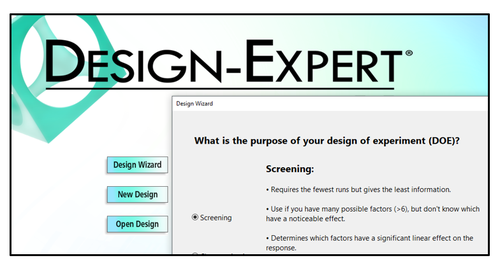Stat-Ease Blog

Categories
Two World-Class Speakers Confirmed for the 2019 Analytics Solutions Conference Keynotes

Two globally-recognized speakers are committed to keynote the 2019 Analytics Solutions Conference. This premier conference on the applications of industrial analytics, featuring DOE, MVA, and PAT, is being held in Minneapolis, MN June 18-20. The speakers are:
- Dr. Geoff Vining is an acclaimed statistics researcher, internationally known for his expertise in the use of experimental design for quality, productivity, and reliability improvement and in the application of statistical process control. Geoff will present his views on "Solving Complex Problems".
- Dr. R. Dennis Cook is known worldwide for his pioneering work on linear and nonlinear regression, experimental design and statistical graphics, but best known as the inventor of the Cook's distance statistic that plays a prominent role in model diagnostics. Dennis will provide "A Primer on Partial Least Squares Regression".
For more information on these talks, head to the ASC 2019 Speakers Page
Would you like to speak? Submit an abstract! All the details can be found on the 2019 Analytics Solutions Conference webpage.
2019 Analytics Solutions Conference Announcement
Discover how data-driven tools can transform your business from R&D to production
Stat-Ease and Camo Analytics are partnering together to host the premier conference on the practical applications of industrial analytics. Topics feature industrial analytics methods; in particular design of experiments (DOE), multivariate analysis (MVA) and process analytical technology (PAT).
The 2019 Analytics Solutions Conference is the perfect venue to discover how others are using these statistical tools to dramatically impact the bottom line. It's a great place to make connections and get inspired. Industries include, but are not limited to: pharmaceutical, medical device, electronics, food science, oil and gas, chemical processes, and aerospace.
It will be held June 18-20 near the Stat-Ease headquarters in Minneapolis, MN — a great time to visit Minnesota. The conference will include workshops, keynote speakers, and fun evening events.
If you have a success story that can be shared, please submit an abstract by February 15. All the details can be found on the Call for Speakers page.
We hope to see you here this coming year!
Four Questions that Define Which DOE is Right for You
Do you ever stare at the broad array of DOE choices and wonder where to start? Which design is going to provide you with the information needed to solve your problem? I’ve boiled this down to a few key questions. Each of them may trigger more in-depth conversation, but the answers are key to driving your design decisions.
- What is the purpose of your experiment? Typical purposes are screening, characterization, and optimization. The screening design will help identify main effects (it’s important to choose a design that will estimate main effects separately from two-factor interactions (2FI)). Characterization designs will estimate 2FI’s and give you the option to add center points to detect curvature. Optimization designs generally estimate non-linear, or quadratic effects. (See the blog “A Winning Strategy for Experimenters”.)
- Are your factors actually components in a formulation? This leads you to a mixture design. Consider this question – if you double all the components in the process, will the response be the same? If yes, then only mixture designs will properly account for the dependencies in the system. (Check out the Formulation Simplified textbook.)
- Do you have any Hard-to-Change factors? An example is temperature – it’s hard to randomly vary the temp setting higher and lower due to the time required to stabilize the process. If you were planning to sort your DOE runs manually to make it easier to run the experiment, then you likely have a hard-to-change factor. In this case, a split-plot design will give a more appropriate analysis.
- Are your factors all numeric, or all categoric, or some of each? Multilevel categoric designs work better with categoric factors that are set at more than 2 levels. A final option: optimal designs are highly flexible and can usually meet your needs for all factor types and require only minimal runs.

These questions, along with your budget for number of runs, will guide your decisions regarding what type of information is important to your business, and what type of factors you are using in the experiment. Conveniently, the Design Wizard in Design-Expert® software (pictured left) asks these questions, guiding you through the decision-making process, ultimately leading you to a recommended starting design.
Give it a whirl – Happy Experimenting!
Building a Stronger Team at Stat-Ease

I would like to introduce our newest Stat-Ease team member: Greg Campbell.
Greg is tackling his role as Marketing Manager with energy and a determination to make Stat-Ease® shine! I wanted to learn more about Greg and his thoughts for our company’s future, so I asked him a few questions. Here’s what he had to say:
Tell us a little about your background:
It’s varied. I started with a BA in Biology and worked in a biochemistry lab. I then got my MBA in Marketing and Computer Information Systems and have worked in sales and marketing at different companies over the years (mostly in publishing and manufacturing). Most recently, I founded a company with a partner that sold parts for industrial machinery. All of these items pushed me down the path towards Stat-Ease.
What attracted you to joining the Stat-Ease team?
First, I liked the people I met here; friendly and smart. Next, this company sells a robust piece of software that has been around for years. It’s a great combination that allowed me to get back to concentrating on sales and marketing, it’s what I do best!
You’ve attended a Stat-Ease DOE class – what did you learn about our clients?
That sample size is small and insignificant (see what I did there?), but interesting. Most of the clients I met were engineers and cringed at the mere mention of the word ‘statistics’. But they picked up the concepts quickly and started to run with them! They began planning and using what they had just learned to think about how to run some experiments.
What strikes you as something that people should know about DOE?
You don’t have to like, or completely understand, the statistical theories that form the foundation of DOE (look at my example above). We’ve done all the heavy lifting and programming, now they just need to use the software to get their answers and move on to the next step in their job.
Tell us something about your personal story.
Well in my spare time I like to coach “diamond sports”, baseball and softball. I spent several years coaching baseball for my oldest son. He’s now aged out of those community programs. Now, it’s all about softball with my youngest daughter. Many of the basics of the two sports are the same, but there are lots of differences as well.
Music is also a big part of who I am, both listening to it and playing it. I’m a guitarist and listen to all types of music.
On behalf of the Stat-Ease team, I welcome Greg to Stat-Ease and look forward to working with him!
A Winning Strategy for Experimenters!
A winning business strategy lays out a path with small steps that allows for changes in direction along the way. Our “SCO” flowchart for experimenters is a prime example of such a template for success. Its tried-and-true* core is screening (“S”), characterization (“C”) and optimization (“O”). However, we added one last, but perhaps most important, step: Confirmation. Let’s dive into the Stat-Ease strategy for experimenters and find out what makes it work so well.

Our starting point is the Screening design. Screening designs provide a broad, but shallow, search for previously unknown process factors. TIP – don’t bother screening factors that are already known to affect your responses! Newly discovered factors—the “vital few” carry forward into the next phase of experimentation, with the “trivial many” being cast aside. By using medium-resolution (Res IV) designs—color-coded yellow in the primary two-level factorial builder in Design-Expert® software (DX), you can screen for main effects even in the presence hidden interactions. If runs must be closely budgeted, take advantage of the unique Minimum-Run Screening designs in DX.
Moving ahead to Characterization with the vital-few screened factors plus the big one(s) you set aside, the identification of two-factor interactions becomes the goal. This necessitates a high-resolution design (Res V or better)—the green ones in DX’s main builder. To save runs, consider a Minimum-Run Characterization design. Either way, be sure to add center points at this stage so you can check curvature. If curvature is NOT significant, then your mission is nearly complete—all that remains is Confirmation!
If curvature does emerge as being significant and important, then move on to Optimization using response surface methods (RSM). The beauty of RSM is that, with the aid of DX and its modeling and graphics tool, you can see by contour and 3D maps where each response peaks. Also, via numerical tools, DX can pinpoint the setup of factors producing the most desirable outcome for multiple responses. Then it lays out a compelling visual of the sweet spot—the window where all specifications can be achieved.
Last, but not least, comes Confirmation, during which you do a number of runs to be sure you can reproduce the good results. Use the special tool for confirmation that DX provides to be confident of this.
In conclusion, DOE does not provide a single template that you can repeat over and over. You must apply a strategy, such as the one outlined here, that adapts at each stage of your journey to a new and improved process that saves money at an improved quality level. Why not go after it all!
Learn more about the Stat-Ease strategy for experimenters by attending the Modern DOE for Process Optimizationworkshop or by reading the DOE Simplified textbook.
*Strategy of experimentation: Break it into a series of smaller stages, Mark Anderson, StatsMadeEasy blog, 6/20/11.
